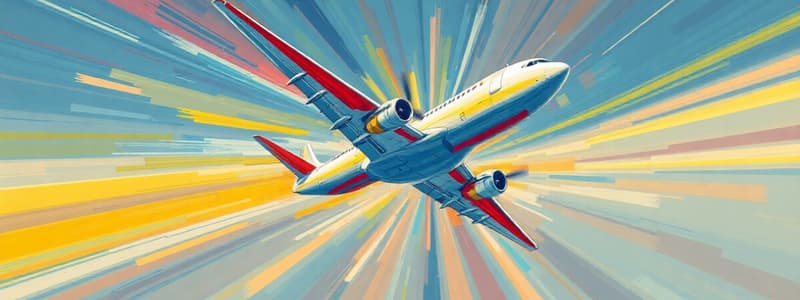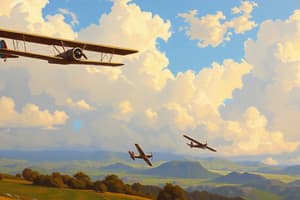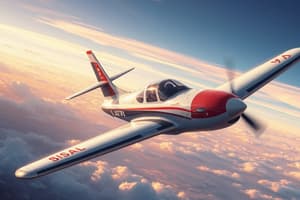Podcast
Questions and Answers
Which control surface is primarily used to produce yaw in an aircraft?
Which control surface is primarily used to produce yaw in an aircraft?
- Aileron
- Flap
- Elevator
- Rudder (correct)
What does static stability refer to in aviation?
What does static stability refer to in aviation?
- The aircraft’s ability to return to equilibrium after a disturbance. (correct)
- The resistance of an aircraft to roll.
- The aircraft's ability to maintain a constant altitude.
- The maximum speed an aircraft can achieve.
What is the primary function of the horizontal stabilizer on an aircraft?
What is the primary function of the horizontal stabilizer on an aircraft?
- To increase the speed of the aircraft.
- To maintain pitch stability. (correct)
- To control yaw when turning.
- To assist in the aircraft's roll.
Dynamic stability in aviation refers to which of the following concepts?
Dynamic stability in aviation refers to which of the following concepts?
Which axis is related to roll in an aircraft's motion?
Which axis is related to roll in an aircraft's motion?
What role does angle of attack play in aircraft performance?
What role does angle of attack play in aircraft performance?
How do ailerons contribute to aircraft balance and control?
How do ailerons contribute to aircraft balance and control?
What is a primary design consideration for aircraft stability?
What is a primary design consideration for aircraft stability?
What effect does an increase in thrust have on the aircraft if the thrust line is low?
What effect does an increase in thrust have on the aircraft if the thrust line is low?
How is lateral stability primarily enhanced in aircraft design?
How is lateral stability primarily enhanced in aircraft design?
When an aircraft is trimmed for hands-off control, what indicates static stability?
When an aircraft is trimmed for hands-off control, what indicates static stability?
What is the role of the horizontal stabilizer in aircraft stability?
What is the role of the horizontal stabilizer in aircraft stability?
What happens to the angle of attack on a wing when it experiences a sideslip due to a gust?
What happens to the angle of attack on a wing when it experiences a sideslip due to a gust?
Which of the following indicates positive stability during flight?
Which of the following indicates positive stability during flight?
Which design factor contributes to lateral stability by causing the aircraft to return to level flight after a roll?
Which design factor contributes to lateral stability by causing the aircraft to return to level flight after a roll?
What generally characterizes an aircraft with neutral stability?
What generally characterizes an aircraft with neutral stability?
What effect does increasing the angle of attack (AOA) have on the center of lift (CL) in asymmetrical airfoils?
What effect does increasing the angle of attack (AOA) have on the center of lift (CL) in asymmetrical airfoils?
How does a horizontal stabilizer contribute to aircraft balance when the center of lift (CL) is behind the center of gravity (CG)?
How does a horizontal stabilizer contribute to aircraft balance when the center of lift (CL) is behind the center of gravity (CG)?
What is the primary consequence of static longitudinal instability in an aircraft?
What is the primary consequence of static longitudinal instability in an aircraft?
Which factor does NOT directly contribute to establishing static longitudinal stability in an aircraft?
Which factor does NOT directly contribute to establishing static longitudinal stability in an aircraft?
What happens to the moments acting on an aircraft if it suddenly enters a nose-up attitude?
What happens to the moments acting on an aircraft if it suddenly enters a nose-up attitude?
What role does the angle of attack play in the movement of the center of lift?
What role does the angle of attack play in the movement of the center of lift?
Which of the following describes a common correction for an aircraft that is nose-heavy?
Which of the following describes a common correction for an aircraft that is nose-heavy?
What is the relationship between the center of gravity (CG), center of lift (CL), and tail surface during flight?
What is the relationship between the center of gravity (CG), center of lift (CL), and tail surface during flight?
Study Notes
Aircraft Rotation
- Aircraft have three axes of rotation: pitch, yaw, and roll
- Pitch is nose up or down around a wing-to-wing axis, controlled by elevators
- Yaw is nose left or right around a vertical axis, controlled by rudder
- Roll is rotation about a nose-to-tail axis, controlled by ailerons
- Spacecraft control systems use thrusters for similar rotations
Stability
- Aircraft stability is the inherent ability to correct for disturbances and maintain flight path
- Two types of stability: static and dynamic
- Static stability is the initial tendency to return to equilibrium
- Static stability is desirable as it helps the aircraft regain airspeed and balance
- Dynamic Stability is the continuous response to disturbances over time
Longitudinal Stability
- Refers to stability along the aircraft's longitudinal axis
- Positive longitudinal stability means the aircraft will return to a stable flight path after a disturbance
- Negative longitudinal stability means the aircraft will continue to move away from a stable flight path after a disturbance
- Neutral longitudinal stability means the aircraft will maintain a steady oscillation after a disturbance
- Thrust can affect longitudinal stability, a high thrust line can counteract nose-up forces
- The location of the Center of Gravity (CG) is important:
- CG forward of the Center of Lift (CL) leads to static longitudinal stability
- CG aft of the CL leads to static longitudinal instability
- Horizontal tail surfaces are important for longitudinal stability:
- Tail surfaces provide a stabilizing force
- Trimmed aircraft are in a hands-off equilibrium state
Lateral Stability
- Refers to stability around the aircraft's lateral axis (roll)
- Positive lateral stability helps the aircraft return to a level flight path after a disturbance
- Negative lateral stability means the aircraft will roll further after a disturbance
- Lateral stability is determined by several design factors:
- Dihedral: upward angle of wings provide lateral stability
- Sweepback: angled wings increase stability
- Keel effect: vertical tail surface creates a stabilizing force
- Weight distribution: centered weight promotes stability
- Longitudinal instability makes an aircraft prone to dives or climbs, making it dangerous to fly
- CL position is critical:
- CL forward of the CG means the aircraft is "nose heavy"
- CL rearward of the CG means the aircraft is "tail heavy"
- Horizontal stabilizer is crucial:
- It provides the downward force needed to balance nose-heavy airplanes
- A negative angle of attack on the stabilizer ensures a downward force
Studying That Suits You
Use AI to generate personalized quizzes and flashcards to suit your learning preferences.
Related Documents
Description
Explore the fundamental concepts of aircraft rotation and stability in this quiz. You will learn about the three axes of rotation, types of stability, and the essential characteristics affecting aircraft performance. This knowledge is crucial for anyone interested in aviation and aerodynamics.




